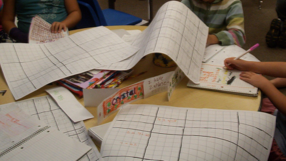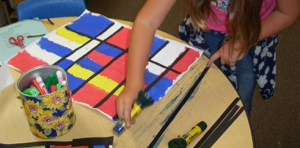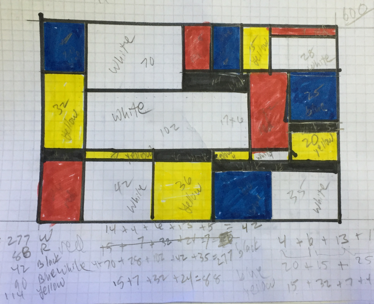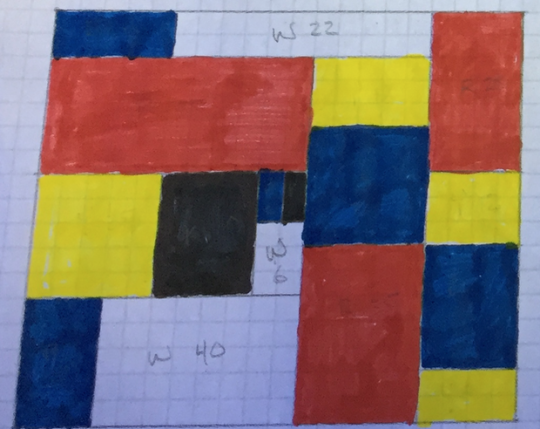Lesson 2: Mondrian Inspired Art
Activities
Pairs carefully paint their projects according to their plans. (Note, they will be adding black tape to their projects which will hide minor inaccuracies, but it is worth taking the time to be careful and paint within the lines. Straight edges can be used to help guide the paint brushes.) This should be completed at least 3 hours before Task 4 so there is sufficient drying time. Note: their computation and notes may show through the paint. That is just fine.
Launch
Today we’re going to finish up our projects with narrow black tape along all the edges of our rectangles. We don’t need to put down 2 pieces of tape when two rectangles share a side, just one for the border between them.
First we’re going to compute the distance around our whole canvas. The distance all the way around a rectangle or any other polygon is called a perimeter. How many inches is it around the outside of your canvas?
That great big rectangle doesn’t have any shared sides. But next we’ll figure out the length of all the shared sides. How much tape will you need in all? First you’ll estimate how much you’ll need. Imagine a ruler that is 12”. Use that to think about when you make your estimate. Record your estimate, than actually compute the amount of tape you’ll need using any strategy that makes sense to you.
Math Task
Pairs work to determine the length of their perimeter, then estimate and compute the length of tape they’ll need over all for their project.
Synthesis
Whole group discussion about the difference between measuring areas and measuring lengths. Really explore what kinds of things are measured in lengths (1-dimension) vs. area (2-dimensions). Discuss the importance of identifying the kinds of units you are using to measure. In this case, inches or square inches. Pairs should revisit their recording sheet and identify the units they used for each measurement. (MATH/LANGUAGE NOTE: square inches is prefered for 3rd grade, rather than in2 as students haven’t been introduced to exponents yet, and there is a intuitive linguistic connection between square inches and counting/determining the number of inches required to fill a plane.)
Discuss that linear measurements are used to find distances and lengths of things, (including perimeters - distances around).
Both linear and area measurements are cumulative. That is to say, you can put 2 or more lengths together and add them to find the total length (e.g., for the perimeter or amount of tape used) and you can put 2 or more area measures together to find the total (e.g., finding the total for each color…) (NOTE: All geometric measures are additive).
Distribute tape.
Maker Task
Pairs add tape to the perimeter and the boundary lines between their rectangles to complete their Painting Inspired by Mondrian. Students’ recording sheets should be taped to the back of their projects.
Gallery Walk & Treasure Hunt
Pairs circulate around the room, admiring their classmates’ art. On their second loop around the room, they should be on the lookout for the following:
- The largest canvas area/perimeter (may or may not be the same)
- The smallest canvas area/perimeter (may or may not be the same)
- The most/least yellow area
- The most/least blue area
- The most/least red area
- The most/least white area
- The most/least black area
- Other interesting features
Synthesis
Students regroup to discuss final thoughts regarding the project. Class discusses both the aesthetic experience and the mathematics.
Teacher summarizes new, growing, and solidified ideas regarding geometric measurement, (area and length), and multiplication using an area model, computation strategies, as well as substantive computation practice.
The maker project can be repeated if desired.
Note: Some of these samples are practice sketches by SSU Maker Instructors Ben Ford, Carol Keig, and Kathy Morris. Others are images from Gena Richman’s 2nd/3rd grade students, completing a similar task with slightly different task parameters.




Materials for this Lesson:
Check materials table on previous page.
Timeline:
Task 3 - Painting: 20 minutes
- Paint according to plan
- This must be done either the day prior to Lesson 2
- Tasks 4 & 5 or at least several hours earlier so that the paint is dry
Task 4 - Determining Tape Lengths: 25 minutes
- Launch: 5 minutes
- Math -- Compute Tape length: 10 minutes
- Synthesis & Distribution: 10 minutes
Task 5 - Completing and Sharing Art: 25 minutes
- Maker -- Taping the project: 15 minutes
- Gallery Walk Treasure Hunt: 5 minutes
- Synthesis: 5 minutes

